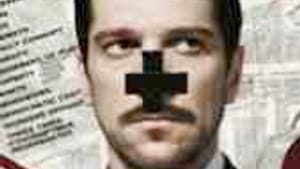Stay in the Loop
BSR publishes on a weekly schedule, with an email newsletter every Wednesday and Thursday morning. There’s no paywall, and subscribing is always free.
What The Nose knows (and William Kentridge doesn't)
Shostakovich's "The Nose' at the Met

Dmitri Shostakovich is well known as the last great symphonist (to date) of the Western classical tradition. What's far less known is that his early ambition was to compose operas, and that he had even planned a grand, thematic tetralogy on the model of Wagner's Ring cycle.
The subject was to be not the fortunes of a great male hero like Siegfried, but those of the modern woman in her quest for social and sexual freedom. In Jungian terms, the cycle he planned would have represented the female principle in balance— or antagonism?— to Wagner's anthropocentric one.
Shostakovich the feminist? Yes; and the one opera of the cycle he did complete, Lady Macbeth of the Mtsensk District, had as its theme a doomed adulterous affair in tsarist Russia that ended in Siberian exile and death for the protagonist.
That opera was abruptly suppressed by Stalin, who had tolerated it for several years in a long-running Moscow production but, just embarking on the show trials of the Great Terror, decided that depicting a prison gang onstage was no longer comme il faut. Shostakovich was, with good reason, in fear for his life, and he never completed a full-length dramatic opera again.
Lady Macbeth remained unproduced for 30 years, and only gradually worked its way into the Western repertoire. Quite lost in the shuffle was Shostakovich's earlier, satiric opera, The Nose, which is only now, a full 80 years after its premiere, making its debut at the Metropolitan Opera in New York.
Russia's Kafka
The Nose is based on the Gogol short story that bears the same relation to the absurdist tradition in Russian literature as Kafka does in German and Beckett in English. Kovalyov, a minor bureaucrat in the St. Petersburg of Nicholas I, wakes up one day without his nose after a visit to the barber's. The sexual connotations are obvious enough, as are the connections to the equation between sexual and political freedom that would surface more explicitly in Lady Macbeth.
The nose grows to full human size, sprouts legs and cavorts around the city, putting on airs and rank. The dangerously liberated member is finally set upon by a mob— detumesced, as it were— and reattached to its owner's face.
Gogol's story is only a sketch, and Shostakovich fleshes it out (if you'll permit the pun) with crowd scenes and set pieces obviously applicable to the Soviet Russia of the 1920s. In some respects, Russia had never known a freer decade, and despite the new Communist state's political isolation there was considerable cultural commerce with the West.
Sending up bourgeois opera
Shostakovich was certainly abreast of musical experimentation there, and his score bristles with atonal and polytonal writing of a sort he would only be able to allude to after the early '30s. Elements of Expressionist opera— particularly Berg's Wozzeck— are incorporated, and Shostakovich shows familiarity with Hindemith's jazz-inspired Jonny spielt auf, then just produced.
The Nose is, in fact, a grand deconstruction of the Romantic opera tradition, with the young composer gleefully sending up every "bourgeois" stage convention he can think of. Making mock of the bourgeoisie also provided convenient cover for satirizing Soviet society as well, and the anti-utopian implications of The Nose make it a deeply and uproariously subversive work on all counts. As the eternal bureaucrat, Shostakovich suggests, Kovalyov will survive every change of regime; but his nose will always wriggle loose.
One giant distraction
The Met's production is, unfortunately, problematic. The large cast— there are 78 vocal roles— is spirited, and the crowd scenes are strikingly choreographed. Conductor Valery Gergiev did splendidly in the pit. The issue is guest director William Kentridge's overbearing mise-en-scène, which reduces the stage space to a bare tableau and— with the giant, Constructivist-themed backdrop that serves as a screen for a constant stream of projected images, animations and snippets of dialogue— does its hyperkinetic best to upstage the actual proceedings and reduce the music to a commentary on the design, instead of vice versa.
Certainly, The Nose calls for a production sensitive to its historic context. We are now about as many years removed from its composition as its first audiences were from the world of Nicholas I it notionally depicted, and with what we know of the Stalinist repression that lay ahead, it is impossible to see the opera without a sense of far grimmer ironies than The Nose was able to report. But Kentridge's setting is about Kentridge, in much the same way as Franco Zeffirelli's baroque decor for Puccini was about him.
Who's that fellow?
There is a moment in which the rotating black lines Kentridge projects on his screen assemble themselves into the visage of a Shostakovich partly youthful and partly old. This might seem, superficially, an act of homage, until one realizes that it's Shostakovich himself— that is, his actual music, his work— that we are being distracted from.
What is Kentridge telling us here? We are all aware that the opera is Shostakovich's, and his momentarily projected image adds nothing to that fact. It lingers a moment and then disassembles itself, one more isolated image among literally hundreds in Kentridge's puppet theater.
In short, it's exactly the reverse of homage; it's appropriation.
Kentridge is not the only culprit of this stripe on our cultural scene, which more and more dines on travesty. It's too bad the Met decided to afford him such license, though, and to sell the talents of almost everyone else involved in the production so short— Shostakovich and Gogol most of all.
The subject was to be not the fortunes of a great male hero like Siegfried, but those of the modern woman in her quest for social and sexual freedom. In Jungian terms, the cycle he planned would have represented the female principle in balance— or antagonism?— to Wagner's anthropocentric one.
Shostakovich the feminist? Yes; and the one opera of the cycle he did complete, Lady Macbeth of the Mtsensk District, had as its theme a doomed adulterous affair in tsarist Russia that ended in Siberian exile and death for the protagonist.
That opera was abruptly suppressed by Stalin, who had tolerated it for several years in a long-running Moscow production but, just embarking on the show trials of the Great Terror, decided that depicting a prison gang onstage was no longer comme il faut. Shostakovich was, with good reason, in fear for his life, and he never completed a full-length dramatic opera again.
Lady Macbeth remained unproduced for 30 years, and only gradually worked its way into the Western repertoire. Quite lost in the shuffle was Shostakovich's earlier, satiric opera, The Nose, which is only now, a full 80 years after its premiere, making its debut at the Metropolitan Opera in New York.
Russia's Kafka
The Nose is based on the Gogol short story that bears the same relation to the absurdist tradition in Russian literature as Kafka does in German and Beckett in English. Kovalyov, a minor bureaucrat in the St. Petersburg of Nicholas I, wakes up one day without his nose after a visit to the barber's. The sexual connotations are obvious enough, as are the connections to the equation between sexual and political freedom that would surface more explicitly in Lady Macbeth.
The nose grows to full human size, sprouts legs and cavorts around the city, putting on airs and rank. The dangerously liberated member is finally set upon by a mob— detumesced, as it were— and reattached to its owner's face.
Gogol's story is only a sketch, and Shostakovich fleshes it out (if you'll permit the pun) with crowd scenes and set pieces obviously applicable to the Soviet Russia of the 1920s. In some respects, Russia had never known a freer decade, and despite the new Communist state's political isolation there was considerable cultural commerce with the West.
Sending up bourgeois opera
Shostakovich was certainly abreast of musical experimentation there, and his score bristles with atonal and polytonal writing of a sort he would only be able to allude to after the early '30s. Elements of Expressionist opera— particularly Berg's Wozzeck— are incorporated, and Shostakovich shows familiarity with Hindemith's jazz-inspired Jonny spielt auf, then just produced.
The Nose is, in fact, a grand deconstruction of the Romantic opera tradition, with the young composer gleefully sending up every "bourgeois" stage convention he can think of. Making mock of the bourgeoisie also provided convenient cover for satirizing Soviet society as well, and the anti-utopian implications of The Nose make it a deeply and uproariously subversive work on all counts. As the eternal bureaucrat, Shostakovich suggests, Kovalyov will survive every change of regime; but his nose will always wriggle loose.
One giant distraction
The Met's production is, unfortunately, problematic. The large cast— there are 78 vocal roles— is spirited, and the crowd scenes are strikingly choreographed. Conductor Valery Gergiev did splendidly in the pit. The issue is guest director William Kentridge's overbearing mise-en-scène, which reduces the stage space to a bare tableau and— with the giant, Constructivist-themed backdrop that serves as a screen for a constant stream of projected images, animations and snippets of dialogue— does its hyperkinetic best to upstage the actual proceedings and reduce the music to a commentary on the design, instead of vice versa.
Certainly, The Nose calls for a production sensitive to its historic context. We are now about as many years removed from its composition as its first audiences were from the world of Nicholas I it notionally depicted, and with what we know of the Stalinist repression that lay ahead, it is impossible to see the opera without a sense of far grimmer ironies than The Nose was able to report. But Kentridge's setting is about Kentridge, in much the same way as Franco Zeffirelli's baroque decor for Puccini was about him.
Who's that fellow?
There is a moment in which the rotating black lines Kentridge projects on his screen assemble themselves into the visage of a Shostakovich partly youthful and partly old. This might seem, superficially, an act of homage, until one realizes that it's Shostakovich himself— that is, his actual music, his work— that we are being distracted from.
What is Kentridge telling us here? We are all aware that the opera is Shostakovich's, and his momentarily projected image adds nothing to that fact. It lingers a moment and then disassembles itself, one more isolated image among literally hundreds in Kentridge's puppet theater.
In short, it's exactly the reverse of homage; it's appropriation.
Kentridge is not the only culprit of this stripe on our cultural scene, which more and more dines on travesty. It's too bad the Met decided to afford him such license, though, and to sell the talents of almost everyone else involved in the production so short— Shostakovich and Gogol most of all.
What, When, Where
The Nose. Opera by Dmitri Shostakovich; directed by William Kentridge; Valery Gergiev, conductor. Through March 25, 2010 at Metropolitan Opera, Lincoln Center, Broadway and 65th St., New York. (212) 362-6000 or www.metopera.org.
Sign up for our newsletter
All of the week's new articles, all in one place. Sign up for the free weekly BSR newsletters, and don't miss a conversation.

 Robert Zaller
Robert Zaller